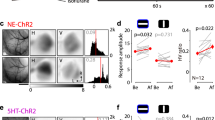Abstract
IN many regions of the cerebral cortex, Ca2+ influx through NMDA (N-methyl-D-aspartate) sensitive glutamate receptors (NMDA receptors) can trigger two forms of synaptic plasticity: long-term depression (LTD) and long-term potentiation (LTP)1. LTD is induced by low levels of postsynaptic NMDA-receptor activation, for instance in response to low-frequency stimulation, whereas LTP is induced by the stronger activation that occurs following high-frequency stimulation2–4. Theoretical studies have shown that the properties of synaptic LTD and LTP can account for many aspects of experience-dependent plasticity in the developing visual cortex, provided that the LTD-LTP crossover point (the modification threshold, Θm) varies as a function of the history of cortical activity5–7. Here we provide direct experimental evidence that the value of Θm depends on sensory experience. We find in visual cortex of light-deprived rats that LTP is enhanced and LTD diminished over a range of stimulation frequencies, and that these effects can be reversed by as little as two days of light exposure. Our findings support the idea that a variable synaptic-modification threshold allows synaptic weights in neural networks to achieve a stable equilibrium.
Similar content being viewed by others
Author information
Authors and Affiliations
Rights and permissions
About this article
Cite this article
Kirkwood, A., Rioult, M. & Bear, M. Experience-dependent modification of synaptic plasticity in visual cortex. Nature 381, 526–528 (1996). https://doi.org/10.1038/381526a0
Received:
Accepted:
Issue Date:
DOI: https://doi.org/10.1038/381526a0
- Springer Nature Limited
This article is cited by
-
Acute exercise as a modifier of neocortical plasticity and aperiodic activity in the visual cortex
Scientific Reports (2023)
-
Weight dependence in BCM leads to adjustable synaptic competition
Journal of Computational Neuroscience (2022)
-
Pharmacological and optical activation of TrkB in Parvalbumin interneurons regulate intrinsic states to orchestrate cortical plasticity
Molecular Psychiatry (2021)
-
Energetics of stochastic BCM type synaptic plasticity and storing of accurate information
Journal of Computational Neuroscience (2021)
-
Toward a generalized Bienenstock-Cooper-Munro rule for spatiotemporal learning via triplet-STDP in memristive devices
Nature Communications (2020)





